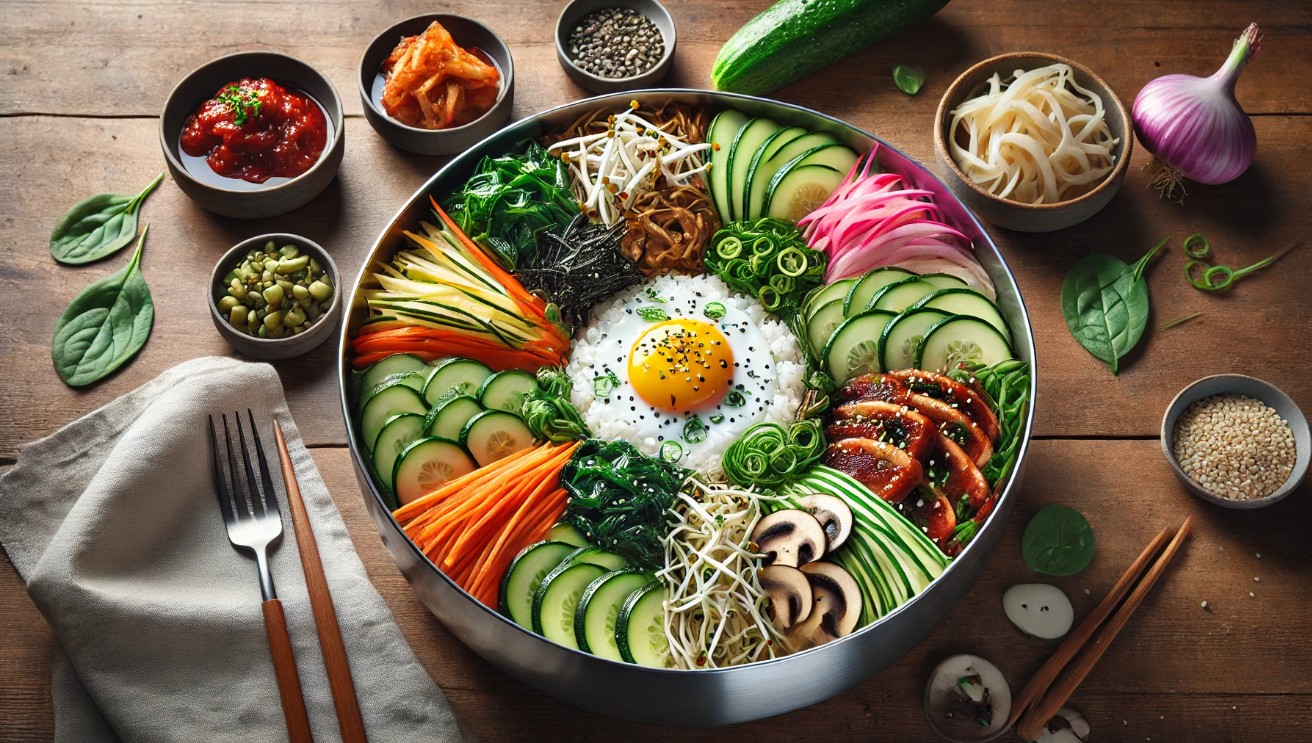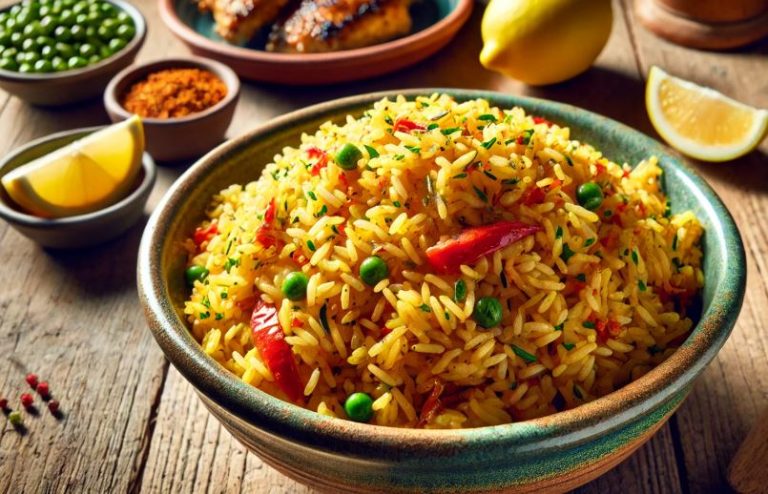Yangpun Bibimbap is a vibrant and colorful Korean rice dish served in a large bowl with an assortment of fresh vegetables, savory meat, a fried egg, and a spicy-sweet gochujang (Korean chili paste) sauce.
The name “Yangpun” means “large bowl,” making this dish perfect for serving large portions or sharing with family and friends. With its balance of flavors, textures, and nutrients, Yangpun Bibimbap is a beloved staple in Korean cuisine.
Why is Yangpun Bibimbap Recipe Famous?
Yangpun Bibimbap is famous for its visually stunning presentation, nutritional balance, and customizable nature. Unlike traditional bibimbap served in a hot stone bowl (dolsot), Yangpun Bibimbap is served in a large stainless steel bowl, allowing for a larger variety and quantity of toppings.
The medley of fresh, cooked, and pickled vegetables, along with protein options like beef, chicken, or tofu, provides a healthy, filling meal suitable for vegetarians, vegans, and meat lovers alike.
The vibrant colors of the vegetables make this dish visually appealing, while the interplay of textures—crisp, chewy, and tender—keeps every bite interesting.
The famous gochujang-based sauce ties all the elements together, offering a tangy, spicy, and slightly sweet flavor profile that elevates the dish.
Yangpun Bibimbap Recipe Ingredients
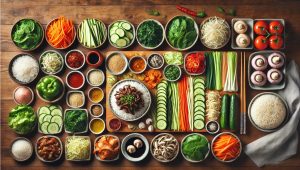
For the Rice
| Quantity | Ingredient |
| 2 cups | Cooked white rice (short-grain) |
For the Meat (Optional)
| Quantity | Ingredient |
| 200g | Bulgogi beef, chicken, or pork (marinated) |
| 1 tbsp | Cooking oil |
For the Vegetables
| Quantity | Ingredient |
| 1/2 cup | Spinach (blanched) |
| 1/2 cup | Carrot (julienned) |
| 1/2 cup | Zucchini (julienned) |
| 1/2 cup | Shiitake mushrooms (sliced) |
| 1/2 cup | Bean sprouts (blanched) |
| 1/2 cup | Kimchi (chopped) |
| 1 | Cucumber (julienned) |
| 1 | Red bell pepper (julienned) |
| 1/4 cup | Radish (pickled) |
| 1/4 cup | Green onions (chopped) |
For the Sauce
| Quantity | Ingredient |
| 3 tbsp | Gochujang (Korean chili paste) |
| 1 tbsp | Soy sauce |
| 1 tbsp | Sesame oil |
| 1 tbsp | Rice vinegar |
| 1 tbsp | Honey (or sugar) |
| 2 tsp | Minced garlic |
| 1 tsp | Gochugaru (Korean chili flakes) (optional) |
For Toppings
| Quantity | Ingredient |
| 1 | Egg (fried) |
| 1 tbsp | Toasted sesame seeds |
| 1 sheet | Nori (seaweed) (cut into thin strips) |
Yangpun Bibimbap Recipe Instructions
Step 1: Prepare the Rice

- Cook 2 cups of short-grain white rice according to package instructions.
- Fluff the rice with a fork and set it aside.
Step 2: Cook the Meat

- Heat 1 tbsp of cooking oil in a pan over medium heat.
- Add 200g of bulgogi beef, chicken, or pork (marinated) and cook for 5-7 minutes or until fully cooked.
- Remove from heat and set aside.
Step 3: Prepare the Vegetables

- Blanch spinach and bean sprouts in boiling water for 1-2 minutes. Drain and set aside.
- Heat a pan with a small amount of oil and stir-fry carrots, zucchini, and shiitake mushrooms separately for 2-3 minutes each.
- Julienne the cucumber, red bell pepper, and radish. Chop the kimchi and green onions.
- Set all the vegetables aside for assembly.
Step 4: Make the Sauce

- In a mixing bowl, combine gochujang, soy sauce, sesame oil, rice vinegar, honey, minced garlic, and gochugaru.
- Mix well until the sauce is smooth and well combined.
Step 5: Assemble the Yangpun Bibimbap

- In a large stainless steel bowl, place a generous portion of rice as the base.
- Arrange the prepared vegetables in sections on top of the rice, creating a colorful display.
- Add the cooked meat to the center or on the side.
- Place a fried egg on top.
- Drizzle the gochujang sauce over the dish.
- Garnish with toasted sesame seeds, seaweed strips, and chopped green onions.
Step 6: Serve and Enjoy
- Before eating, mix everything together with chopsticks or a spoon to evenly coat the rice and toppings with the sauce.
- Serve immediately and enjoy a wholesome, flavorful meal.
Yangpun Bibimbap Recipe Variations

Classic Yangpun Bibimbap
Instructions:
- Prepare the Rice: Cook 1 cup of short-grain white rice and keep it warm.
- Make the Sauce: Combine 3 tbsp gochujang, 1 tbsp sesame oil, 1 tbsp rice vinegar, 1 tbsp sugar, 2 tsp minced garlic, 1 tsp gochugaru (optional), salt, and pepper. Mix well.
- Prepare the Toppings: Sauté 1/2 cup of spinach, julienne 1/2 carrot, and 1/2 zucchini. Cook 1 egg sunny-side up or fry it to your desired consistency. Slice 1/4 cup of kimchi, and cut 1 sheet of nori into strips. Optional: Pan-fry or grill thinly sliced beef (e.g., bulgogi) for added protein.
- Assemble: Place the cooked rice in a bowl, top with sautéed vegetables, kimchi, fried egg, and any additional toppings. Drizzle the sauce over the top.
- Serve: Toss the ingredients together before eating. Serve immediately.
Difference: The classic Yangpun Bibimbap showcases fresh, sautéed vegetables, a fried egg, and a flavorful spicy-sweet sauce, offering a harmonious combination of textures and flavors.
Seafood Yangpun Bibimbap
Instructions:
- Prepare the Rice: Cook rice as in the classic recipe and keep warm.
- Make the Sauce: Prepare the same spicy-sweet sauce.
- Prepare the Seafood: Lightly sauté or grill 150g of shrimp, squid, and/or octopus.
- Prepare the Toppings: Sauté vegetables (spinach, carrots, zucchini), slice kimchi, and prepare a fried egg as in the classic recipe.
- Assemble: Add the seafood on top of the rice, followed by the sautéed vegetables, kimchi, fried egg, and sauce.
- Serve: Toss and serve.
Difference: The seafood version adds fresh, briny shrimp, squid, or octopus, creating a seafood-forward version that enhances the dish’s umami flavor.
Vegetarian Yangpun Bibimbap
Instructions:
- Prepare the Rice: Cook rice as in the classic recipe and keep warm.
- Make the Sauce: Prepare the same spicy-sweet sauce.
- Prepare the Toppings: Instead of meat, use pan-fried tofu or tempeh, sautéed mushrooms, spinach, julienned carrots, and zucchini. Add slices of avocado or pickled radish for extra flavor.
- Assemble: Place the rice in a bowl, top with tofu, sautéed vegetables, fried egg, and sauce.
- Serve: Toss and serve.
Difference: This vegetarian version replaces the meat with tofu and mushrooms, offering a wholesome, plant-based alternative that’s just as satisfying as the original.
Spicy Yangpun Bibimbap
Instructions:
- Prepare the Rice: Cook rice as in the classic recipe and keep warm.
- Make the Sauce: Add extra gochugaru (Korean chili flakes) and a dash of chili oil to the classic spicy-sweet sauce for more heat.
- Prepare the Toppings: Sauté vegetables and prepare the fried egg, as in the classic recipe.
- Assemble: Top the rice with the extra-spicy sauce, vegetables, kimchi, and fried egg.
- Serve: Toss and serve.
Difference: This fiery version of Yangpun Bibimbap is for spice lovers, incorporating extra chili flakes and oil for a bold, intense heat.
Meat Lover’s Yangpun Bibimbap
Instructions:
- Prepare the Rice: Cook rice as in the classic recipe and keep warm.
- Make the Sauce: Prepare the same spicy-sweet sauce.
- Prepare the Meat: Grill or pan-fry 150g of bulgogi beef, pork belly, or chicken breast and slice thinly.
- Prepare the Toppings: Sauté vegetables and prepare the fried egg as in the classic recipe.
- Assemble: Layer the rice with the grilled meat, vegetables, fried egg, and sauce.
- Serve: Toss and serve.
Difference: This version incorporates grilled bulgogi beef, pork belly, or chicken, making it a protein-rich, savory variation that’s perfect for meat lovers.
Yangpun Bibimbap Recipe Serving Suggestions
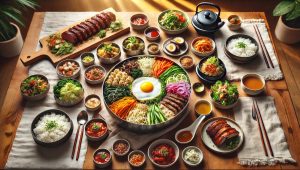
As a Main Course
Yangpun Bibimbap is a fulfilling and well-balanced dish with savory rice, sautéed vegetables, a fried egg, and a flavorful sauce. Add grilled meats like bulgogi, chicken, or even seafood to enhance the protein content and make it a heartier meal. It’s a perfect option for lunch or dinner.
As a Side Dish
Pair Yangpun Bibimbap with grilled Korean BBQ dishes like samgyeopsal or galbi. The vibrant, spicy-sweet flavors of the bibimbap contrast beautifully with the smoky richness of BBQ meats, creating a delightful and well-rounded meal.
As a Light Lunch
For a lighter yet satisfying meal, enjoy Yangpun Bibimbap without the added protein, focusing on the sautéed vegetables, rice, and egg. This makes for a quick, healthy lunch that’s both nourishing and refreshing, ideal for a midday boost.
As a Meal Prep Option
Prepare the components of Yangpun Bibimbap in advance—cook the rice, sauté the vegetables, and prepare the sauce. Store the ingredients separately and assemble when needed for a quick, flavorful, and nutritious meal. This is an excellent choice for busy days when you want a homemade meal with minimal effort.
Yangpun Bibimbap Recipe Nutrition Details
| Nutrient | Amount per Serving |
| Calories | 550 |
| Protein | 20g |
| Carbohydrates | 72g |
| Fat | 12g |
| Fiber | 6g |
| Sodium | 900mg |
Note: Nutritional values may vary depending on ingredient choices and portion sizes.
Conclusion
Yangpun Bibimbap is a colorful, nutritious, and versatile dish that brings together fresh vegetables, flavorful protein, and spicy-sweet gochujang sauce.
Its visual appeal, balanced taste, and hearty portions make it perfect for any occasion—whether as a family meal, a lunchbox option, or a shared dining experience.
Customizable for vegetarians, vegans, and meat lovers, Yangpun Bibimbap is a beloved dish that continues to delight food enthusiasts worldwide.
FAQs for Yangpun Bibimbap Recipe
What makes Yangpun Bibimbap different from traditional bibimbap?
Yangpun Bibimbap is served in a large stainless steel bowl, allowing for more toppings and larger portions compared to traditional bibimbap served in a hot stone bowl.
Can I customize the ingredients in Yangpun Bibimbap?
Yes, you can adjust the vegetables, protein (beef, chicken, tofu, or seafood), and even omit ingredients for dietary preferences like vegetarian or vegan.
What is the best type of rice for Yangpun Bibimbap?
Short-grain white rice is traditional due to its sticky texture, but you can use brown rice for a healthier option.
What can I serve Yangpun Bibimbap with?
It can be a main course, side dish, or light lunch. It pairs well with grilled Korean BBQ or can be enjoyed without meat for a lighter meal.
How spicy is Yangpun Bibimbap?
The dish has a mild to medium spice level, but you can adjust the heat by adding more gochujang or chili flakes for extra spice.
Can I make Yangpun Bibimbap ahead of time?
Yes, you can prepare the rice, vegetables, and sauce in advance, then assemble when ready to serve.
What are the nutritional benefits of Yangpun Bibimbap?
Yangpun Bibimbap is a balanced meal with carbohydrates, protein, fiber, and healthy fats, offering about 550 calories per serving, depending on the ingredients.
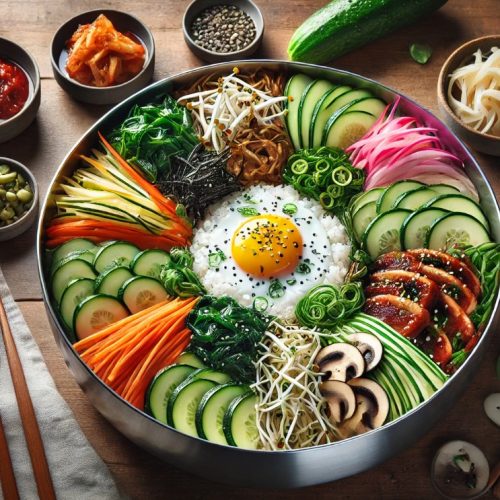
Yangpun Bibimbap Recipe
Ingredients
- 2 cups Cooked white rice
- For the Meat
- 200 g Bulgogi beef
- 1 tbsp Cooking oil
- For the Vegetables
- 1/2 cup Spinach
- 1/2 cup Carrot
- 1/2 cup Zucchini
- 1/2 cup Shiitake mushrooms
- 1/2 cup Bean sprouts
- 1/2 cup Kimchi
- 1 Cucumber
- 1 Red bell pepper
- 1/4 cup Radish
- 1/4 cup Green onions
- 3 tbsp Gochujang
- 1 tbsp Soy sauce
- 1 tbsp Sesame oil
- 1 tbsp Rice vinegar
- 1 tbsp Honey
- 2 tsp Minced garlic
- 1 tsp Gochugaru
- 1 Egg
- 1 tbsp Toasted sesame seeds
- 1 sheet Nori
Instructions
- Cook 2 cups of short-grain white rice according to package instructions.
- Fluff the rice with a fork and set it aside.
- Heat 1 tbsp of cooking oil in a pan over medium heat.
- Add 200g of bulgogi beef, chicken, or pork (marinated) and cook for 5-7 minutes or until fully cooked.
- Remove from heat and set aside.
- Blanch spinach and bean sprouts in boiling water for 1-2 minutes. Drain and set aside.
- Heat a pan with a small amount of oil and stir-fry carrots, zucchini, and shiitake mushrooms separately for 2-3 minutes each.
- Julienne the cucumber, red bell pepper, and radish. Chop the kimchi and green onions.
- Set all the vegetables aside for assembly.
- In a mixing bowl, combine gochujang, soy sauce, sesame oil, rice vinegar, honey, minced garlic, and gochugaru.
- Mix well until the sauce is smooth and well combined.
- In a large stainless steel bowl, place a generous portion of rice as the base.
- Arrange the prepared vegetables in sections on top of the rice, creating a colorful display.
- Add the cooked meat to the center or on the side.
- Place a fried egg on top.
- Drizzle the gochujang sauce over the dish.
- Garnish with toasted sesame seeds, seaweed strips, and chopped green onions.
- Before eating, mix everything together with chopsticks or a spoon to evenly coat the rice and toppings with the sauce.
- Serve immediately and enjoy a wholesome, flavorful meal.


